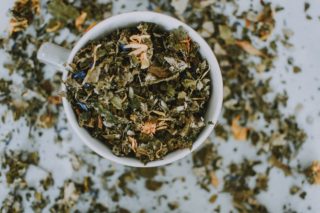There is no shortage of terms for synthetic marijuana, the most common being K2 and spice. Regardless of its label, it is essential to understand that synthetic marijuana is a manmade substance. Synthetic marijuana attempts to invoke a high similar to cannabis, but it is incredibly dissimilar. Spice can be extremely dangerous.
Spice Abuse and Addiction Treatment Options


Table of Contents
What is Spice and How is it Sold?
While it is commonly sold in liquid form, Spice can also be sold as a combination of dried herbs or crushed leaves that have been sprayed with the Spice. The plant matter itself has no impact on the body, but the cannabimimetic (chemicals) that are sprayed on it will produce a high similar to tetrahydrocannabinol (THC), which is the primary psychoactive compound found in the marijuana plant.
Over 11,000 people were treated for Spice-related hospitalizations in 2010, according to the Partnership for Drug-Free Kids. Unfortunately, after Spice became illegal in 2012, these statistics are more difficult to measure. Prior to 2012, Spice could be purchased at gas stations, convenience stores, and head shops with ease. In some states, there are still some formulas that skirt laws due to policies that need broader refinements, explains the Drug Policy Alliance1https://drugpolicy.org/are-synthetic-cannabinoids-legal.
Presently, manufacturers and importers continue to deceive the public and law enforcement by selling spice in the guise of, “herbal incense.” The incense is intended to be smoked or brewed as tea, but is labeled as, “not for human consumption,” and packaged in bright foil wrappers with various names to avoid detection by law enforcement and retailers. Street names like Spice and K2 were adopted and utilized to help market the product to those looking for synthetic marijuana.
Because Spice continues to be sold around the world, it leaves some consumers with the impression that it is safe. Conversely, Spice can be as lethal as its synthetic counterparts being sold around the world. It is critical to recognize the symptoms and side effects of Spice usage to avoid lasting negative health effects.
Who Is Using Spice?
Previously, one of the biggest factors that made Spice appealing to consumers was that it did not appear on a drug test. However, modern drug tests can catch a variety of drug usage, including Spice. Consumers can be introduced to Spice in various ways and settings; individuals who can be susceptible to Spice use can vary in demographic.
At-Risk Groups
There is no one specific group of the American population that is subject to abusing Spice. While any individual can develop an addiction to Spice, age seems to be one of the biggest indicators of risk. Since youth and young adults are some of the most likely to experiment with drugs, they are one of the highest risk groups for using Spice.
Socioeconomic class may also be an indicator of risk. Because synthetic drugs can be low cost and are created to be highly potent, America’s homeless population and incarcerated population can be at higher risk. This potency may be alluring to individuals with other existing substance abuse disorders or mental health disorders, which can exacerbate these existing conditions.
Spice Use Amongst Children and Teens
The Partnership for Drug-Free Kids shared that Spice is actually the third most commonly abused drug2https://www.drugabuse.gov/publications/principles-adolescent-substance-use-disorder-treatment-research-based-guide/frequently-asked-questions/what-drugs-are-most-frequently-used-by-adolescents amongst high school students in the United States. Overall, males are more susceptible to abuse than females, with the National Institute on Drug Abuse (NIDA) reporting in 2012 that use of Spice amongst high school students impacted 14% of male students and 8% of female students.
Spice abuse also impacts those younger than high school age, with a more recent survey from 2015 revealing that 3.1% of eighth graders used Spice. While organizations are working to obtain more recent data, it’s apparent that the risks of Spice impact children as significantly as adults in the United States.
Side Effects of Spice Use
While many Americans believe that one is incapable of developing an addiction to marijuana, the Substance Abuse and Mental Health Services Administration reported that 17% of people seeking treatment for an addiction cited marijuana as their drug of choice. The addictive nature of the substance is one of the few things that synthetic and natural marijuana have in common; there are further similarities in the side effects. Some of these side effects3https://www.drugabuse.gov/publications/drugfacts/synthetic-cannabinoids-k2spice include:
- Elevated mood
- Feelings of relaxation
- Altered perception
- Symptoms of psychosis
Spice is significantly more addictive because of its intense, short-lived highs followed by strong withdrawal symptoms, including depression and anxiety. Spice also has numerous side effects that marijuana doesn’t, including:
- Nausea
- Vomiting
- Aggression
- Headaches
- Numbness
- Tremors
- Seizures
- Panic Attacks
- Coma
- Death
Given that Spice is highly addictive with severe symptoms of use and withdrawal, it is essential that spice users seek help in recovery. With professional assistance, an individual can expect their recovery to go much more smoothly while greatly reducing their risk of relapse.
How to Identify Spice Abuse
One of the best ways to identify Spice abuse is to look for changes in behavior. Those abusing substances or suffering from a substance use disorder are likely to withdraw and isolate from loved ones. Because depression can cause an individual to use and abuse addictive substances, it is important to watch for signs of depression and address them early.
Individuals who abuse Spice are likely to experience increased anxiety. Spice produces a sedating high that can lead to significant abnormal behaviors. In households, a warning sign would look like a family member falling asleep at the dinner table or napping throughout random portions of the day. Severe drowsiness during the workday or presenting as disheveled or unwell in a professional setting can be an indicator of Spice abuse.
The side effects of spice are often reversible and fade away as the drug wears off. Because of the addictive nature of synthetic marijuana, withdrawal symptoms can present intensely. These symptoms include paranoia, depression, and mood swings. While marijuana does not usually induce hallucinations or psychosis, Spice often does; If you suspect a loved one is abusing Spice, watch for signs of distress, unexplainable aggression, and other side effects.
The symptoms and side effects of Spice use/abuse should not be minimized. Unlike natural marijuana, overuse of Spice can lead to overdose and potentially death. According to Newsweek, the number of people who died from Spice abuse tripled between 2014 and 2015. If you suspect you or your loved one have an addiction to synthetic marijuana, treatment options are available to confront and eradicate this abuse.
Spice Abuse Treatment Options
Overcoming an addiction can be a strenuous process for individuals. However, withdrawing from synthetic substances like Spice can present severe symptoms. Because Spice produces intense and short-lived feelings of euphoria, users are quick to experience intense withdrawal symptoms that worsen with repeated usage.
Withdrawal symptoms can include (but are not limited to):
- anxiety
- depression
- anger
- paranoia
- elevated blood pressure
- increased heart rate
- numbness in limbs
The Spice Detox Process
Withdrawal is often uncomfortable, but a medical detoxification can help reduce symptoms like anxiety and insomnia through prescribed medication in small doses. Additional services, like group counseling and individual counseling, can aid in treating potential underlying issues that coexist with the addiction. Individualized recovery planning enables the individual to acquire all that is needed in their recovery.
As a whole, the Spice detoxification process won’t take longer than a week. Some clients do not experience any symptoms for the first 24 to 48 hours after they stop using spice. Within this window, mental, emotional, and physical symptoms begin to appear and intensify. After 72 hours, the severity of symptoms begin to subside. For heavy Spice users, the mental and emotional symptoms may continue for up to three weeks.
The detoxification process will carry an individual through the withdrawal period. The goal of detoxification is not to treat the addiction, but to manage the withdrawal symptoms and transition the individual to a level of care that is inclusive of their treatment needs. After permitting the body to adjust to the absence of Spice and conquering the withdrawal symptoms, the next level of treatment enables the individual to build the skills to live Spice free.
Recovery and Treatment
After detoxification, individuals are encouraged to transition to a rehabilitation program where they can participate in therapy, case management, medication management, and other services that promote a healthy mind and body. As with any drug addiction, relapse is a possibility; However, proper support can help prevent relapse and provide individuals the best chance for success.
How Do I Get Help?
Any type of substance use disorder is a serious condition that should be addressed with the support of addiction professionals; Spice abuse is no exception. With the intense side effects and symptoms that come with Spice use, it is paramount that Spice abusers seek out the knowledgeable and friendly experts they need to overcome the addiction and return to their healthy, productive lifestyle.
Instead of trying to go it alone, find a research-based rehabilitative treatment program that will help guide you toward detox and recovery in the long term. Windward Way Recovery is proud to have helped hundreds of patients recover from substance use disorders. Our evidence-based methods and techniques can support you in your recovery journey, too. Are you interested in learning more about the next step?
Windward Way Recovery believes that every individual deserves access to a personalized, proven treatment plan that meets their specific needs. That’s why we offer financial assistance along with a range of programs tailored to your lifestyle and priorities. Contact Windward Way Recovery today!
- 1https://drugpolicy.org/are-synthetic-cannabinoids-legal
- 2https://www.drugabuse.gov/publications/principles-adolescent-substance-use-disorder-treatment-research-based-guide/frequently-asked-questions/what-drugs-are-most-frequently-used-by-adolescents
- 3https://www.drugabuse.gov/publications/drugfacts/synthetic-cannabinoids-k2spice




